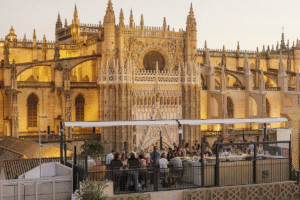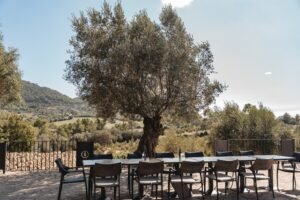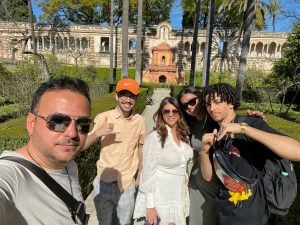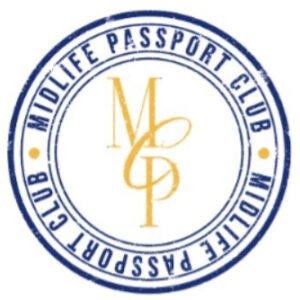Seville does Christmas with flamenco flair. Think nativity scenes in every plaza, streets lit like a golden dream, and enough fried sweets to make your dentist nervous. The city trades its spring fever for something warmer—families strolling through Christmas markets, midnight Mass that actually starts at midnight, and January traditions that stretch the season well into the new year.
Unlike northern Europe’s alpine vibe, Seville keeps it Mediterranean. You’ll wear a jacket, not a parka. You’ll sip hot chocolate thick enough to stand a spoon in, but you might also catch sun on a café terrace. And when December 28 rolls around, prepare for pranks—because Seville’s version of April Fools’ Day lands right between Christmas and New Year’s. Let us chat Christmas in Seville!
This post contains affiliate links.
Getting to Seville for Christmas
Seville is well-connected, but December travel has quirks.
By plane
Seville Airport (SVQ) is small, efficient, and 10 km from the city center. Direct flights from major European cities (London, Paris, Amsterdam, Frankfurt) plus domestic connections through Madrid and Barcelona.
December travel notes:
- Book flights early (October/November) for better prices
- December 20–January 6 sees price spikes and fuller planes
- Airport bus (EA line) runs every 30 min to city center (€4, 35 min)
- Taxis cost €22–25 flat rate to Centro; Uber/Cabify similar
- Consider flying into Málaga (2.5 hrs by bus/train) if Seville flights are expensive
Holiday disruptions: Spanish airports handle Christmas well, but December 24–25 and January 1 have reduced staff and services. Arrive earlier than usual. I love finding bundle deals on Expedia.com.
Also check out New Year’s Eve in Seville.
By train
Seville Santa Justa station connects to Madrid (2.5 hrs via AVE high-speed), Barcelona (5.5 hrs), and Málaga (2 hrs). Trains run through Christmas, but frequencies drop December 24–25.
Tips:
- Book Renfe tickets 60 days out for cheapest fares
- The December 22–23 Madrid→Seville route is packed; reserve seats
- Station has luggage storage (useful if you arrive early on Dec 24)

By bus
ALSA and other carriers connect Seville to Lisbon (6 hrs), Granada (3 hrs), and most Andalusian cities. Cheaper than trains but slower.
Christmas schedule: Buses run December 24–25 but with reduced frequency. Check schedules week-of for changes.
By car
Renting a car works for exploring pueblos blancos or hitting multiple cities, but skip it for Seville itself—parking is brutal and the old town is pedestrian-heavy. To rent a car, check out Discover Cars for best rates.
December driving notes:
- Mountain passes (Ronda, Sierra de Grazalema) can be cold and foggy
- Expect toll roads on A-4 Madrid route
- Gas stations near highways stay open Christmas Day; urban ones close
When is Christmas season in Seville?
The season kicks off around December 8 (Inmaculada Concepción) when lights flip on across the city. Most Christmas markets and activities run through January 6—Día de Reyes (Three Kings’ Day)—which is the big gift-giving day in Spain, not December 25.
Peak dates: December 22–January 6. That’s when markets are fullest, streets are brightest, and every plaza has a Belén (nativity scene) competition happening.
Christmas markets in Seville
Seville’s Christmas markets are smaller and more local than, say, Germany’s sprawling ones, but they nail the atmosphere.
Plaza Nueva Christmas Market
The main event. Wooden huts selling handmade crafts, nativity figurines, ornaments, and plenty of turrones (nougat). It’s compact, walkable, and right next to City Hall—so you can hit the market, grab churros, and wander into the cathedral quarter without breaking stride.
When: Early December through early January
Vibe: Family-friendly, bustling evenings, lots of local artisans

Alameda de Hércules Market
A bit more bohemian. This one skews toward younger crowds, vintage finds, and food trucks. Good for a late afternoon browse before hitting the bars in the area.
Plaza del Duque Market
Smaller, quieter, and tucked near the shopping district. Go here if you want to pick up gifts without the Plaza Nueva crush.
What to buy
Nativity figures (from traditional to hilariously modern), hand-painted ceramics, Spanish Christmas sweets (polvorones, mantecados), olive wood kitchenware, and plenty of handmade jewelry. Cash is king at smaller stalls.
Also check out Things to do in Seville in November.
Christmas lights in Seville (Alumbrado Navideño)
Seville’s lights are not subtle. Avenida de la Constitución, Calle Sierpes, and Plaza Nueva turn into glowing tunnels of stars, ribbons, and chandeliers. The official switch-on happens around December 8, and the city keeps them lit through early January.
Best streets for light-gazing
- Calle Sierpes – the main shopping artery, draped in golden chandeliers
- Avenida de la Constitución – runs from the cathedral toward Plaza Nueva; peak Instagram territory
- Plaza San Francisco – City Hall’s plaza glows all month
- Triana’s Calle Betis – riverside lights with Giralda views
Pro tip: Go after 7 pm when everything’s lit and the streets fill with families. Bring a camera and low expectations for personal space.
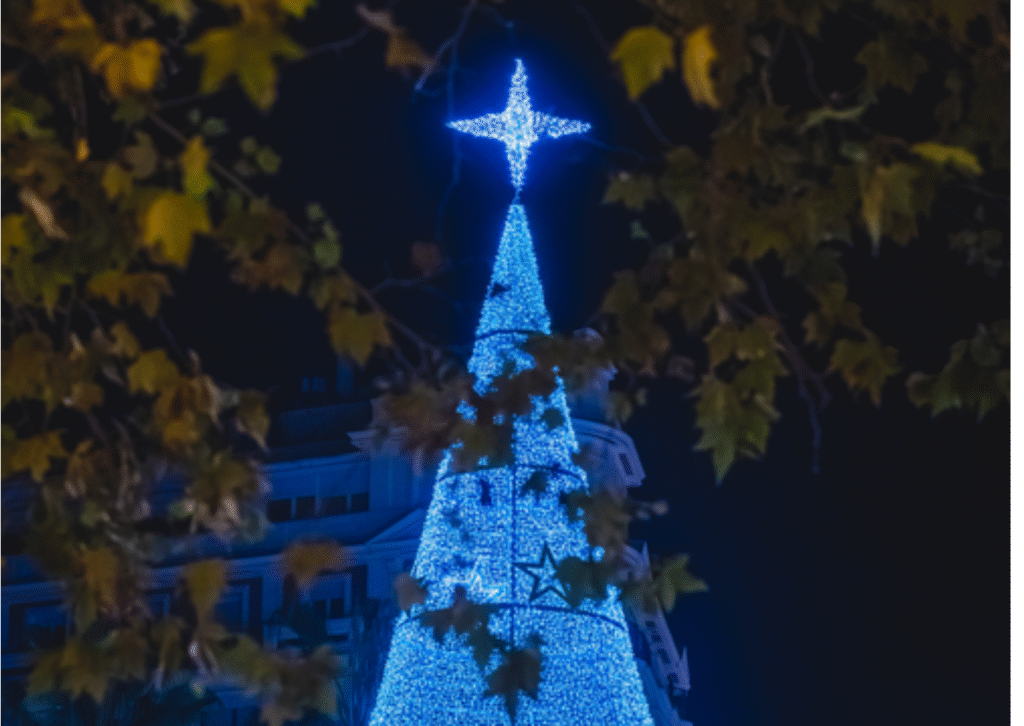
Where to stay in Seville for Christmas
Santa Cruz (Old Jewish Quarter)
Maze-like lanes, close to the cathedral, and dripping with charm. It’s the postcard version of Seville—cobbles, orange trees, and hidden plazas. Expect higher prices and early dinner reservations.
Good for: First-timers, couples, anyone who wants to walk everywhere
Hotels to consider: Hotel Amadeus, Casa de Colón, Las Casas de la Judería
Centro (around Calle Sierpes & Plaza Nueva)
The commercial heart. You’re steps from Christmas markets, shopping, and major monuments. Louder than Santa Cruz but more convenient for families juggling kids and strollers.
Good for: Families, market lovers, shoppers
Hotels to consider: Hotel Inglaterra, Vincci La Rábida, Barceló Sevilla Renacimiento
Triana (across the river)
The working-class neighborhood that invented flamenco and ceramic tiles. It feels more local, less touristy, and you’ll eat better here. Christmas lights on Calle Betis are gorgeous, and the views back to the city are unbeatable.
Good for: Foodies, flamenco fans, anyone who wants neighborhood vibes
Hotels to consider: Hotel Triana, Ribera de Triana Hotel
Alameda de Hércules area
Hipster-adjacent, younger energy, great bar scene. The Christmas market here is smaller but cool, and you’re a quick walk to Centro.
Good for: Solo travelers, night owls, alternative vibes
Hotels to consider: Casual Sevilla de las Letras, boutique Airbnbs
Booking tip: Reserve early if you’re visiting December 20–January 6. Prices spike, and Seville is a popular Spanish domestic destination for the holidays.
What Sevillanos do on Christmas
December 24: Nochebuena (Christmas Eve)
This is the big one. Families gather for a late dinner—think 9 or 10 pm start—featuring seafood, jamón, roasted meats, and mountains of sweets. Restaurants are mostly closed because everyone’s at home.
After dinner, some attend Misa del Gallo (Midnight Mass) at the cathedral. If you’re curious, go—it’s free, atmospheric, and very Seville. Just dress respectfully and arrive early for a seat.
December 25: Navidad (Christmas Day)
Quieter than the 24th. Most shops and restaurants stay closed. Families sleep in, pick at leftovers, and take long walks. If you’re visiting, this is your day to wander empty streets, visit the Alcázar (it’s open), and enjoy the calm.

December 28: Día de los Inocentes
Spain’s version of April Fools’ Day. Expect fake news in the papers, pranks among friends, and general mischief. Media outlets publish satirical stories, and everyone’s in on the joke. It’s harmless fun—just double-check before you believe any wild headlines.
December 31: Nochevieja (New Year’s Eve)
Sevillanos eat 12 grapes at midnight—one for each chime of the clock—for good luck in the new year. Plaza Nueva and the riverfront near Triana fill up with crowds. Some do house parties, others book restaurant menus.
If you’re out, the vibe is cheerful but not wild like Madrid or Barcelona. Expect fireworks (smaller scale), cava toasts, and families bundled up in plazas.
January 1: Año Nuevo (New Year’s Day)
Recovery day. Many places stay closed. Cafés and bakeries open late morning, and people stroll, nurse hangovers, and prep for the next big holiday: Reyes.
January 5: Cabalgata de Reyes (Three Kings Parade)
The grand finale. This parade rivals any Christmas event—elaborate floats, camels (yes, actual camels), thousands of people lining the streets, and candy thrown to kids like confetti.
The Three Kings—Melchior, Caspar, and Balthazar—ride through Seville, and it’s pure magic if you have kids with you. The parade route changes slightly each year but generally winds through Centro, along Avenida de la Constitución, and past the cathedral.
When: Evening of January 5, usually starting around 6–7 pm
Pro tip: Arrive an hour early for a good viewing spot. Bring a bag for catching candy.
January 6: Día de Reyes (Three Kings’ Day)
The actual gift-giving day. Kids wake up to presents left by the Three Kings (not Santa). Families gather again for lunch, often featuring Roscón de Reyes—a ring-shaped cake with hidden surprises inside.
Shops reopen, and this marks the official end of the Christmas season. Decorations come down, markets close, and Seville gets back to business.
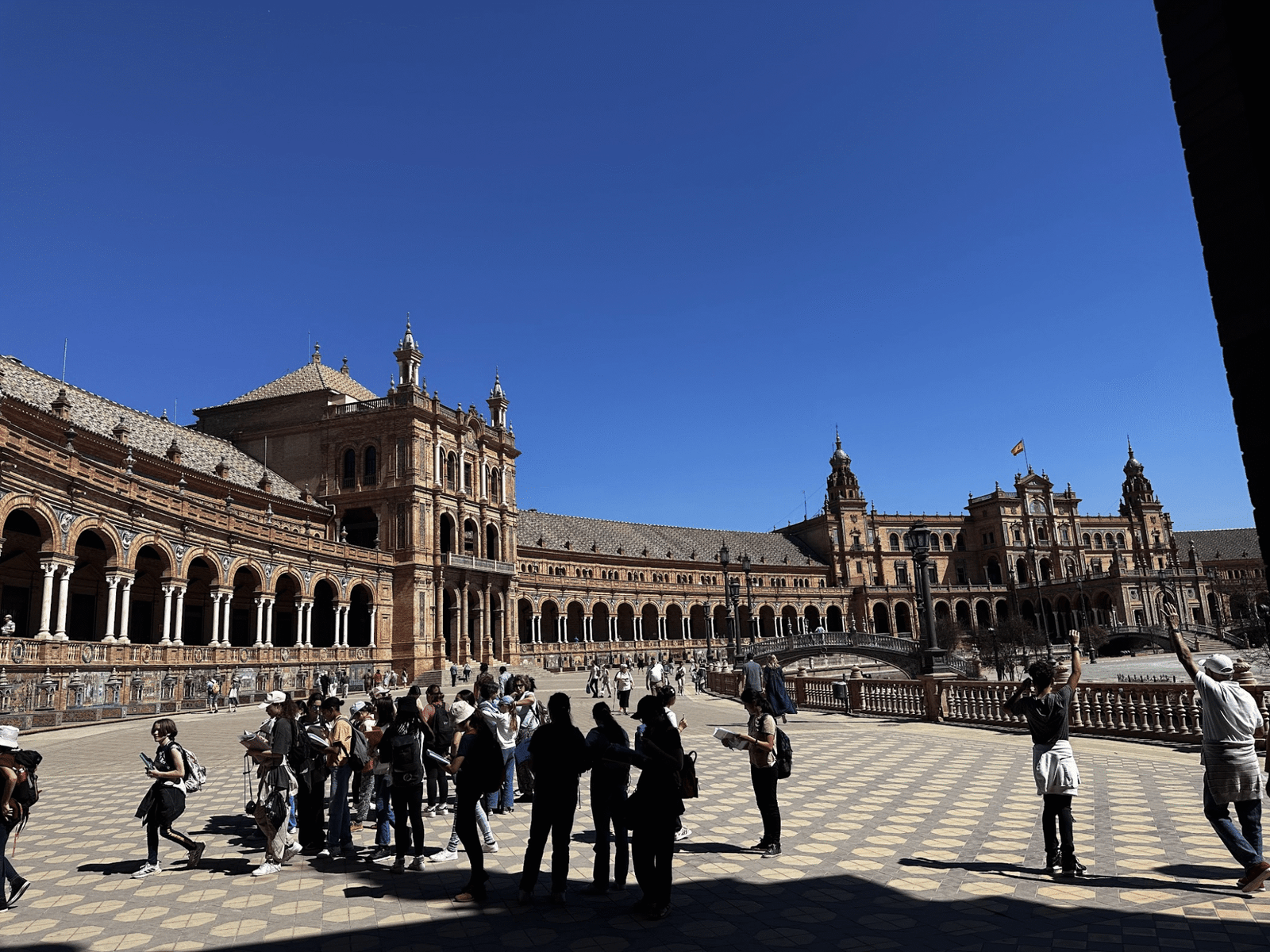
Christmas food traditions in Seville
Seville doesn’t do subtle at the table. The sweets alone could fuel a marathon.
Sweets (Dulces Navideños)
Turrones – Nougat bars, either hard (Alicante-style) or soft (Jijona-style). Almond-heavy, honey-sweet, dangerously addictive.
Polvorones & Mantecados – Crumbly shortbread cookies dusted with powdered sugar. The ones from Estepa (nearby town) are legendary.
Pestinos – Fried dough soaked in honey or sugar syrup. Sticky, sweet, and worth the napkin count.
Mazapán – Marzipan shaped into everything from fruits to nativity figures. Toledo’s version is famous, but Seville bakeries stock plenty.
Roscón de Reyes – The king (pun intended) of Epiphany cakes. A ring of brioche-like dough topped with candied fruit and filled with cream or chocolate. Hidden inside: a figurine (good luck) and a dried bean (you buy next year’s Roscón).

Savory staples
Jamón Ibérico – Always. Christmas is peak jamón season, and every gathering features a leg on a stand.
Mariscos (seafood) – Prawns, clams, percebes (barnacles if you’re fancy), and langostinos dominate Nochebuena tables.
Pavo Trufado – Turkey stuffed with truffles, because why not.
Cordero asado – Roast lamb, especially popular in January around Reyes.
Caldo or consommé – A light soup to start the heavy meal.
Drinks
Hot chocolate – Thick, dark, and served with churros or melindros (sponge fingers). Head to Café de Indias or Bar El Comercio for the real deal.
Anís – Anise liqueur, served at the end of meals. Sweet or dry, depending on your tolerance for licorice vibes.
Cava or champagne – For toasts. Freixenet and Codorníu are the household names, but small-producer cavas are rising.
Vino caliente – Mulled wine, less common than up north but available at some Christmas markets.

Weather in Seville in December
Seville in December is mild but not warm. Pack layers.
Average highs: 16–17°C (61–63°F)
Average lows: 6–8°C (43–46°F)
Rain: Possible, especially mid-month. Bring a compact umbrella or light rain jacket.
Sunshine: Yes, often. You’ll get blue skies mixed with cloudy stretches.
What to wear
Jeans, a warm sweater, and a medium-weight jacket handle most days. Mornings and evenings get chilly, so add a scarf. Comfortable walking shoes are non-negotiable—Seville’s cobbles don’t care about your cute boots.
If you’re attending Midnight Mass or the Reyes parade, bundle up. Standing still in 45°F feels colder than walking.
Christmas Day masses and religious events
Seville is deeply Catholic, and Christmas brings out the ceremonial best.
Misa del Gallo (Midnight Mass) – December 24
Held at the Seville Cathedral, this is the marquee service. Arrive by 11 pm for decent seats. The cathedral’s scale, the organ, and the atmosphere make it memorable even if you’re not religious. Free entry, but dress modestly (no shorts, covered shoulders).
Other church services
Many neighborhood churches hold their own masses. If the cathedral feels too packed or touristy, try:
- Iglesia del Salvador (Plaza del Salvador)
- Basílica de la Macarena (home to Seville’s most beloved Virgin)
- Iglesia de Santa Ana (in Triana, local and lovely)
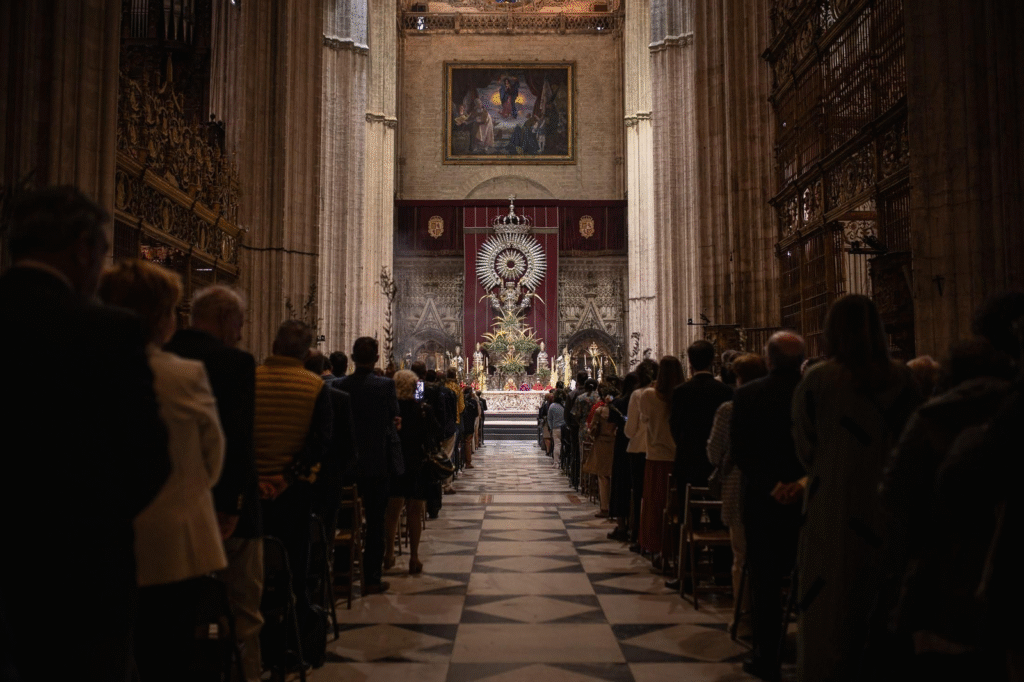
Nativity scenes (Belenes)
Belenes are everywhere. Churches, plazas, museums, even shop windows. Some are traditional (Mary, Joseph, shepherds, the works), others are wildly creative (Belenes made from recycled materials, Lego, or featuring Seville landmarks).
Best Belenes to visit
Belén Monumental de la Plaza de San Francisco – Massive, intricate, and free. Right by City Hall.
Museo de Bellas Artes – Often hosts a special exhibit with historic and artistic nativity scenes.
Neighborhood churches – Wander into any open church in Santa Cruz or Triana; many have beautiful, handmade Belenes.
Belén figurines
Christmas markets sell figurines to build your own. You’ll find traditional characters plus humorous additions—politicians, soccer players, even modern twists like astronauts or DJs in the manger.
Christmas concerts and performances
Seville’s cultural calendar doesn’t slow down in December.
Flamenco shows
Many tablaos (flamenco venues) add Christmas-themed shows. Casa de la Memoria and Museo del Baile Flamenco both run performances through the season. Not traditional Christmas content, but very Seville—and unforgettable.
Classical concerts
Teatro de la Maestranza and other venues host holiday concerts—everything from Handel’s Messiah to Spanish Christmas carols (villancicos). Check schedules in early December.
Street performances
Buskers and choirs pop up in Plaza Nueva, Avenida de la Constitución, and near markets. Free, festive, and often surprisingly good.
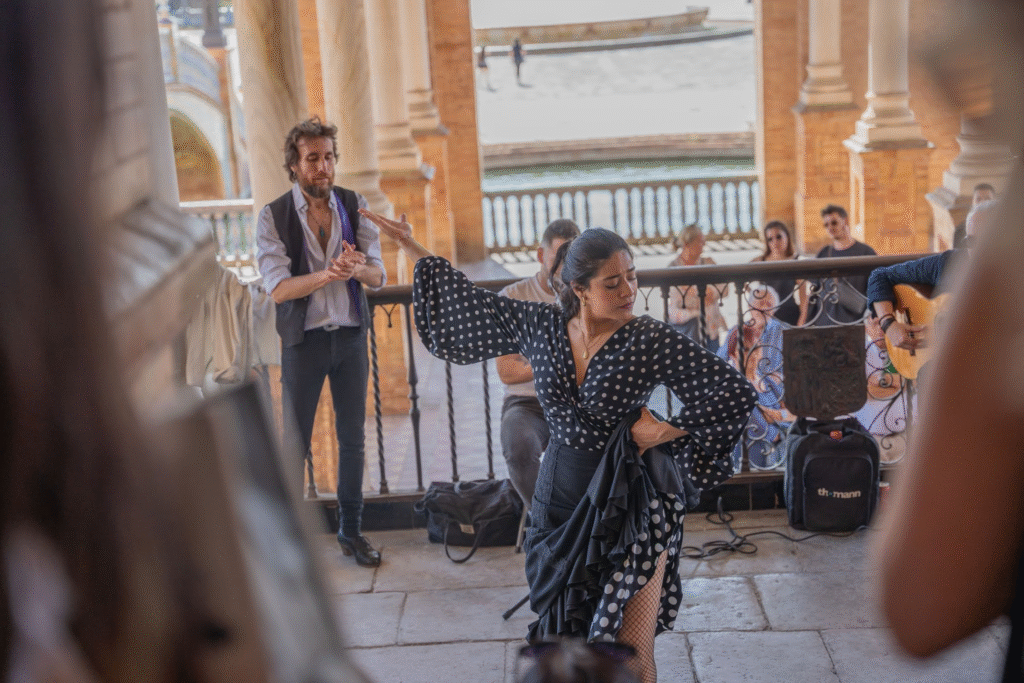
Day trips from Seville during Christmas
If you’re in Seville for a week, consider a side trip:
Córdoba (45 min by train)
The Mezquita is stunning any time, but December brings Christmas markets and quieter crowds. The old Jewish Quarter (Judería) is magical with lights.
Jerez de la Frontera (1 hour by train)
Sherry capital of the world. Tour a bodega, sip fino, and catch an equestrian show at the Royal Andalusian School (they run through December). Jerez also has solid Christmas markets and a beautiful old town.
Ronda (2 hours by bus/train)
Dramatic cliff town with a famous bridge. Cooler weather, fewer tourists in December, and cozy mountain-town vibes. Pair it with a winery visit in the Sierra de Cádiz.
White Villages (Pueblos Blancos)
Rent a car and loop through Arcos de la Frontera, Grazalema, or Zahara de la Sierra. Whitewashed villages, olive groves, and zero crowds. Some villages hold small Christmas markets or nativity contests.
Is Seville good for Christmas with kids?
Yes, but manage expectations. It’s not Lapland.
Pros:
- The January 5 Reyes parade is kid heaven
- Christmas markets have toy stalls and sweets
- Mild weather = easier logistics than snowy destinations
- Alcázar gardens, boat rides in Parque de María Luisa, and playgrounds stay open
Cons:
- December 24–25, most attractions and restaurants close
- Crowds in markets and around lights can be intense
- Late Spanish meal times (9–10 pm dinners) may clash with bedtimes
Family-friendly tips:
- Stay near Plaza Nueva for easy market access
- Book a morning Alcázar visit (less crowded, kids love the peacocks)
- Hit the Isla Mágica theme park if it’s running holiday hours (check dates)
- Keep snacks and patience handy—Spanish schedules are flexible, lines are not
Shopping for Christmas in Seville
Seville’s shopping peaks in December.
Calle Sierpes & Calle Tetuán
Main shopping drags. High-street brands (Zara, Mango, etc.), bookshops, and gourmet food stores. Crowded but convenient.
El Corte Inglés
Spain’s department store giant. One-stop for gifts, gourmet foods (their turrones selection is vast), and souvenirs. The rooftop terrace has decent views and a café.
Triana Market (Mercado de Triana)
For food lovers. Buy jamón, cheeses, olives, and sweets to take home. The market buzz is contagious, and you’ll eat better samples than at any Christmas market.
Ceramics in Triana
Triana is famous for hand-painted tiles and pottery. Pop into workshops along Calle San Jacinto or Calle Alfarería (Potter’s Street) and buy direct from artisans.
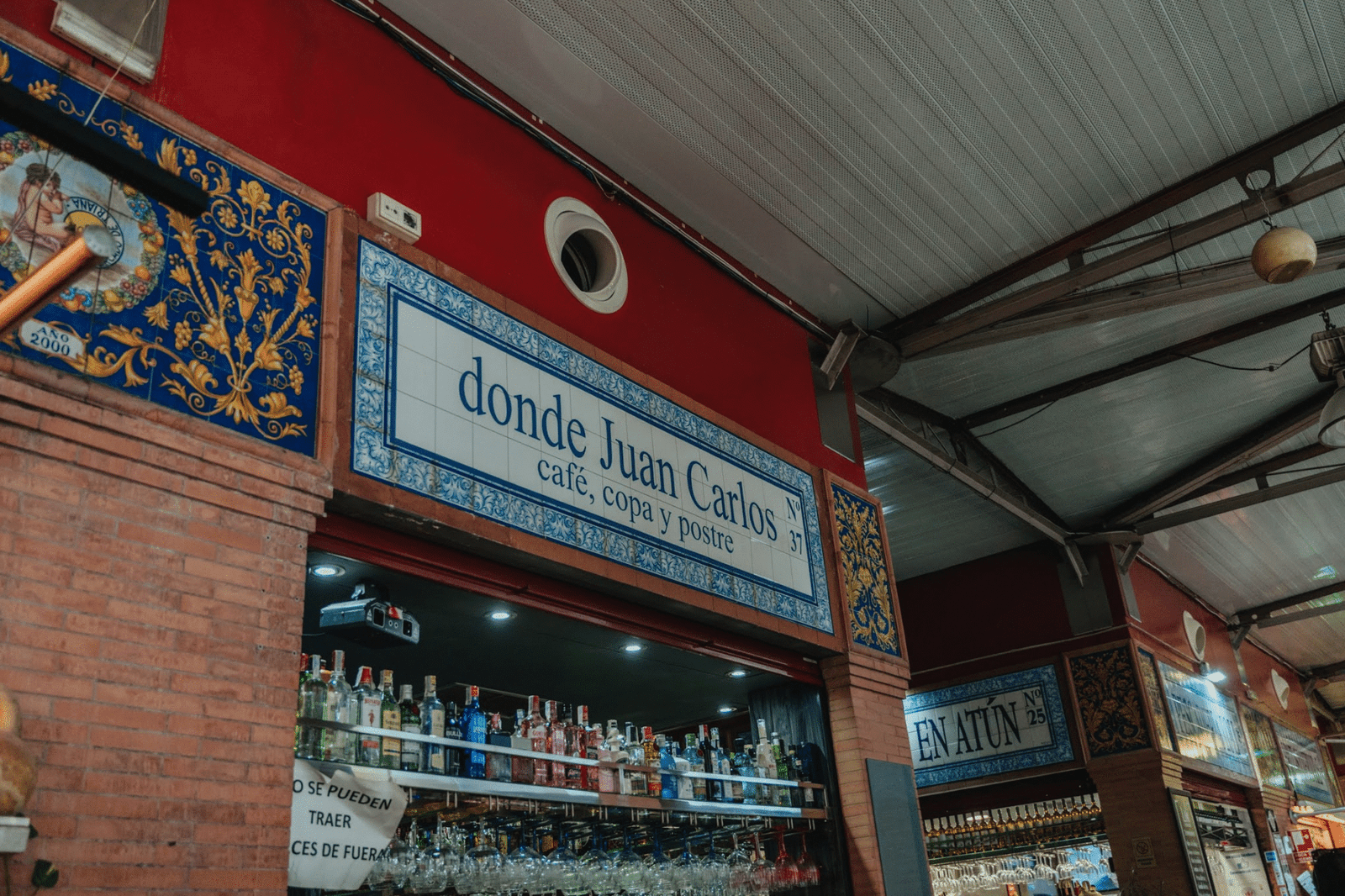
Christmas markets (Mercadillos Navideños)
Best for ornaments, nativity figurines, and handmade crafts. Less ideal for clothing or major gifts.
Shopping hours during Christmas
Regular December schedule (Dec 1–23):
- Monday–Saturday: 10 am–9 pm (most shops)
- Sundays: Some open, especially in tourist zones and El Corte Inglés
December 24 (Christmas Eve):
- Most shops close by 2–3 pm
- Supermarkets and bakeries open mornings only
- Christmas markets usually open until evening
December 25 (Christmas Day):
- Nearly everything closed
- Exception: Some hotel shops, gas station convenience stores
December 26–30:
- Back to normal hours
- Expect crowds as locals hunt for last-minute gifts
December 31 (New Year’s Eve):
- Shops close early (by 6–7 pm)
- Supermarkets open mornings
January 1 (New Year’s Day):
- Closed or very limited hours
January 2–5:
- Extended hours as locals buy Reyes gifts
- Peak shopping chaos—avoid if you hate crowds
January 6 (Reyes):
- Most shops closed; it’s a public holiday
Post-Christmas sales (Rebajas)
Spain’s official winter sales start January 7 (day after Reyes) and run through February. This is when you’ll find real discounts—30–70% off clothing, shoes, homewares.
Best stores for sales:
- Zara, Mango, and other fast-fashion chains slash prices immediately
- El Corte Inglés runs storewide rebajas
- Local boutiques in Santa Cruz and Centro join in by mid-January
Shopping strategy:
- Hit stores January 7–10 for best selection (before sizes/styles sell out)
- Weekdays are less chaotic than weekends
- El Corte Inglés opens early (10 am) on sale launch day—locals line up
Non-sale tip: If you’re buying ceramics, jamón, or olive oil, prices don’t drop. Buy whenever.
How crowded is Seville at Christmas?

Moderate. It’s busy but not July-level insanity.
Peak days: December 22–26 and January 5–6
Quieter days: December 1–20, January 2–4
Near-empty: December 25 (everything’s closed anyway)
Hotels fill up with Spanish families during the final week of December, so book early. Restaurants that stay open on December 24 or 31 often require reservations weeks in advance.
Practical Christmas tips for Seville
Opening hours are chaos. Many shops, restaurants, and even some museums close December 24–25 and January 1. The Alcázar and cathedral usually stay open (reduced hours), but confirm ahead.
ATMs before December 24. Banks close, ATMs get emptied. Pull cash early.
Dining reservations. If you want to eat out on Nochebuena (Dec 24) or Nochevieja (Dec 31), book in November. Seriously.
Spanish schedule applies. Lunch is 2–4 pm, dinner starts at 9 pm. Adjust your stomach clock.
Public transport runs. Buses and trams operate through Christmas, though frequencies drop on December 25 and January 1.
Pack layers. Morning = jacket. Midday sun = T-shirt. Evening = jacket again. Welcome to Seville microclimates.
Learn three phrases:
- Feliz Navidad (Merry Christmas)
- Próspero Año Nuevo (Happy New Year)
- ¿Dónde está el Roscón? (Where is the Roscón?) – You’ll need this on January 6.
Final thoughts: Why spend Christmas in Seville?
Because it’s not cold enough to hate being outside, not touristy enough to feel like a theme park, and just festive enough to make you believe in magic—or at least in the power of fried dough and good lighting.
You’ll walk streets lit like cathedrals, eat sweets your dentist will ask about, and watch camels parade through a medieval city center because that’s just what January 5 demands. You’ll sit in a plaza with hot chocolate thick as pudding, listen to flamenco guitar drift from an open doorway, and realize that Seville doesn’t do Christmas like anywhere else.
Book your hotel early. Pack a jacket. Arrive hungry. And if someone hands you a bag of polvorones, say yes.
Feliz Navidad desde Sevilla.




